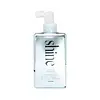What's inside
What's inside
 Key Ingredients
Key Ingredients

No key ingredients
 Benefits
Benefits

 Concerns
Concerns

 Ingredients Side-by-side
Ingredients Side-by-side

Water
Skin ConditioningCetearyl Alcohol
EmollientDimethicone
EmollientCeteareth-20
CleansingStearyl Alcohol
EmollientPropylene Glycol Dicaprylate/Dicaprate
EmollientDiazolidinyl Urea
PreservativePropylene Glycol
HumectantPhenyl Trimethicone
Skin ConditioningAminopropyl Dimethicone
Parfum
MaskingDimethiconol
EmollientBehentrimonium Chloride
PreservativeCetrimonium Chloride
AntimicrobialDipropylene Glycol
HumectantQuaternium-91
Cetrimonium Methosulfate
AntimicrobialButylphenyl Methylpropional
PerfumingLactic Acid
BufferingMalic Acid
BufferingLinalool
PerfumingLimonene
PerfumingSodium Hydroxide
BufferingHexyl Cinnamal
PerfumingAloe Barbadensis Leaf Extract
EmollientIodopropynyl Butylcarbamate
PreservativeGeraniol
PerfumingPhenoxyethanol
PreservativeWater, Cetearyl Alcohol, Dimethicone, Ceteareth-20, Stearyl Alcohol, Propylene Glycol Dicaprylate/Dicaprate, Diazolidinyl Urea, Propylene Glycol, Phenyl Trimethicone, Aminopropyl Dimethicone, Parfum, Dimethiconol, Behentrimonium Chloride, Cetrimonium Chloride, Dipropylene Glycol, Quaternium-91, Cetrimonium Methosulfate, Butylphenyl Methylpropional, Lactic Acid, Malic Acid, Linalool, Limonene, Sodium Hydroxide, Hexyl Cinnamal, Aloe Barbadensis Leaf Extract, Iodopropynyl Butylcarbamate, Geraniol, Phenoxyethanol
Ingredients Explained
These ingredients are found in both products.
Ingredients higher up in an ingredient list are typically present in a larger amount.
Aminopropyl Dimethicone is a type of silicone.
Dipropylene Glycol is a synthetically created humectant, stabilizer, and solvent.
This ingredient helps:
Dipropylene glycol is technically an alcohol, but it belongs to the glycol family (often considered part of the ‘good’ alcohols). This means it is hydrating and gentle on skin unlike drying solvent alcohols like denatured alcohol.
As a masking agent, Dipropylene Glycol can be used to cover the smell of other ingredients. However, it does not have a scent.
Studies show Dipropylene Glycol is considered safe to use in skincare.
Learn more about Dipropylene GlycolParfum is a catch-all term for an ingredient or more that is used to give a scent to products.
Also called "fragrance", this ingredient can be a blend of hundreds of chemicals or plant oils. This means every product with "fragrance" or "parfum" in the ingredients list is a different mixture.
For instance, Habanolide is a proprietary trade name for a specific aroma chemical. When used as a fragrance ingredient in cosmetics, most aroma chemicals fall under the broad labeling category of “FRAGRANCE” or “PARFUM” according to EU and US regulations.
The term 'parfum' or 'fragrance' is not regulated in many countries. In many cases, it is up to the brand to define this term.
For instance, many brands choose to label themselves as "fragrance-free" because they are not using synthetic fragrances. However, their products may still contain ingredients such as essential oils that are considered a fragrance by INCI standards.
One example is Calendula flower extract. Calendula is an essential oil that still imparts a scent or 'fragrance'.
Depending on the blend, the ingredients in the mixture can cause allergies and sensitivities on the skin. Some ingredients that are known EU allergens include linalool and citronellol.
Parfum can also be used to mask or cover an unpleasant scent.
The bottom line is: not all fragrances/parfum/ingredients are created equally. If you are worried about fragrances, we recommend taking a closer look at an ingredient. And of course, we always recommend speaking with a professional.
Learn more about ParfumPhenoxyethanol is a preservative that has germicide, antimicrobial, and aromatic properties. Studies show that phenoxyethanol can prevent microbial growth. By itself, it has a scent that is similar to that of a rose.
It's often used in formulations along with Caprylyl Glycol to preserve the shelf life of products.
Water. It's the most common cosmetic ingredient of all. You'll usually see it at the top of ingredient lists, meaning that it makes up the largest part of the product.
So why is it so popular? Water most often acts as a solvent - this means that it helps dissolve other ingredients into the formulation.
You'll also recognize water as that liquid we all need to stay alive. If you see this, drink a glass of water. Stay hydrated!
Learn more about Water